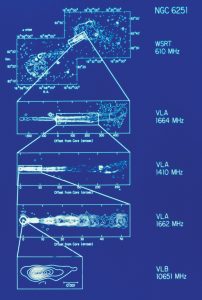SN 1993J was discovered March 28, 1993, by Francisco Garcia Diaz, an amateur astronomer in Lugo, Spain, using a 10-inch Newtonian telescope. Located in M81, a spiral galaxy in the constellation Ursa Major, this supernova is 11 million light-years from Earth. By observing at regular intervals with the Very Long Baseline Array (VLBA), the Very large Array (VLA), and various tracking stations around the world, we have produced this sequence of images showing a shell-like radio structure that has expanded for seven years with circular symmetry. At first the expansion rate was nearly 10,000 miles per second, but it has decelerated since, and had slowed to less than 6,000 miles per second by February, 2000. In this false color image, blue is faintest and red brightest.


Zooming into a Black Hole
This collection of data from a powerful radio galaxy known as NGC 6251 shows the increase in detail astronomers get when they use the Very Large Array and the Very Long Baseline Array. The VLA sees the blobbiness along the jet of material shooting out of a supermassive black hole. The VLBA can see down into the area right around that black hole.

Sco X-1, the Movie
This timelapse movie shows 56 hours of changing radio emission from the violent binary system known as Scorpius X-1. Sco X-1 is a star in orbit around a neutron star, the remnant of a supernova explosion. In June of 1999, Sco X-1 brightened and dimmed, and “lobes” of bright radio emission were pushed outward by jets at about half the speed of light. These lobes are made when the fast moving particles in the jet, created from the accretion disk of material in orbit around the dead star, collide with surrounding material caught in the flow. Notice at the start that one moving set of lobes disappears, but new lobes are ejected from the core a few hours later. The size scale is in billions of miles, because Scorpius X-1 covers a volume much larger than our Solar System.

Blowing in the Winds Animation
In this artist’s animation, a violent system of two giant stars creates incredible amounts of radio waves as their particle winds slam into each other. The system is called W140.





